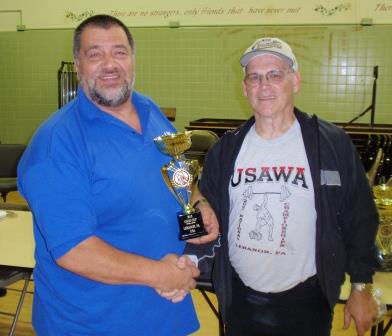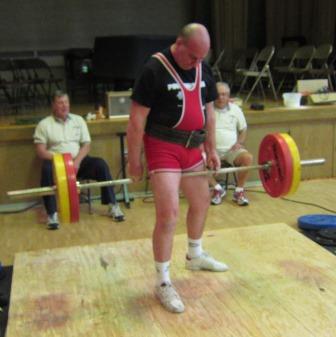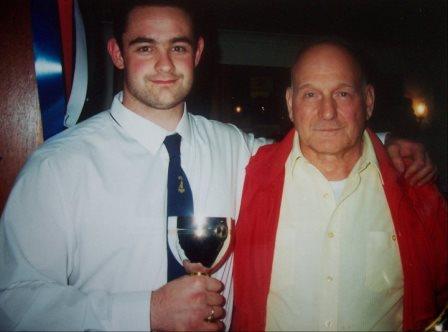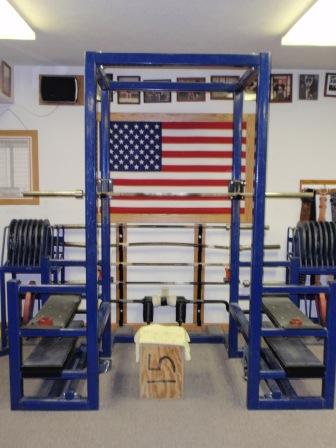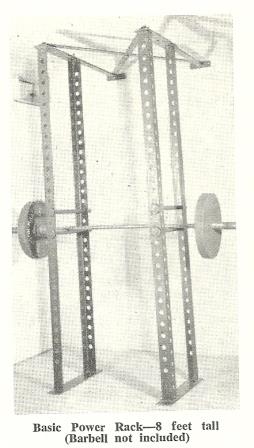My reflections on the Gold Cup
by Al Myers
I’ve just returned from the 2013 IAWA Gold Cup in Lebanon, Pennsylvania. It was an exciting weekend!! Today I’m going to give some of my reflections of “the cup”. This is not intended to be a meet report as I have none of the meet results in hand yet. That will be coming later.
The enjoyment of meets for me goes “way beyond” the day of lifting. It includes the experiences of the travel, visiting with good friends, and learning new things about all round weightlifting. And those things were in abundance with this trip! My father LaVerne was traveling with me, along with training bud Chad Ullom. We flew from KC to Harrisburg early Friday morning and arrived there before noon. My dad has taken an interest in researching the family history of the Myers family, and he had planned out an afternoon agenda for this including meeting some relatives. Our line of the Myers family settled south of Harrisburg near York Springs. We visited a few cemeteries to confirm some of my dad’s research, and actually found the house of Nicholas II Myres (that is the way he spelled our last name!) who was the second generation Myers off the boat. The house was built in 1795 and has been kept in excellent shape. We met the current owners who were quite helpful in our research – as they had a great interest in the history of their house.
After arriving in Lebanon finally after this long day, we were really tired so we decided to just grab a bite to eat and “hit the sack”. I got a full 8 hours of sleep which I needed for the long meet day on Saturday. The meet was held in a venue that Denny has had meets in before. It has a big gym area with lots of lifting space. Upon arriving, I soon met up with many all round friends. It is amazing how many close friendships I have made thru the years from being involved in the USAWA/IAWA. The meet had a very good turnout – and I believe close to 20 lifters were on hand. Steve and Karen Gardner, and Graham and Toni Saxton made the trip from England. All four of them participated in the Cup representing the IAWA(UK). I was so impressed by Karen even competing. She has just recently had a serious surgery and I wasn’t even sure she was going to make the trip, let alone LIFT! However, Karen’s support to the IAWA exceeds most everyone else’s and this proves it. Steve was the first person on the platform doing his big Gold Cup lift in a finger lift, and then spent the rest of the day announcing and scorekeeping. I’ve said this before but it needs repeating again. Steve and Karen Gardner and Denny and Judy Habecker are the FOUNDATION of our organization. They are the ones that hold everything together in both the IAWA(UK) and the USAWA, and gives the IAWA the leadership that allows us to be successful and well-organized. Judy spent the day helping keep score, and providing the “behind the scenes” work that made the day go smoothly.
I was glad to see Toni Saxton make it to the platform for the FIRST TIME. She performed her VB lift perfectly. Graham Saxton is as seasoned IAWA lifter as there it. He did a huge middle fingers straddle deadlift, and a Hand and Thigh Lift (which I believe was the first time he has ever tried it?). Graham also spent most of the day in the officials chair. I consider Graham one of the best officials in IAWA and I know things will be “done right” when he’s judging the lifts. The Gold Cup is intended to be an international competition, and the presence of these four from the Powerhouse Gym in Burton, England made it happen!
It was indeed a day of “who’s who” in attendance. The room was full of USAWA Hall of Famers and the elite lifters from our organization. I was very glad to see Jim Malloy there competing, as well as his Cleveland training partner Scott Schmidt. These two Hall of Famers have been a mainstay in the history of the USAWA. Speaking of Cleveland – I was REALLY surprised to see Dennis Mitchell returning to the platform so quickly following knee replacement. Dennis has been a long time IAWA supporter and has attended as many IAWA events as any other lifter in the history of the organization, so a little “bump in the road” like a knee replacement wasn’t going to keep him away! Frank Ciavattone made the trip to the GC as well. Frank is another USAWA Hall of Famer and future promoter of the 2014 IAWA Worlds. Frank performed one of his signature lifts – the one handed Ciavattone Grip Deadlift. It’s always a pleasure to see Frank at work in a meet. Another East Coast lifter – James Fuller – made his FIRST Gold Cup appearance. Jim did the ever-difficult Bent Press Anyhow as his Gold Cup lift, and finished with a great lift of 60 kilograms. I’ve always said the Bent Press is one of the most painful lifts to watch, and probably to do.
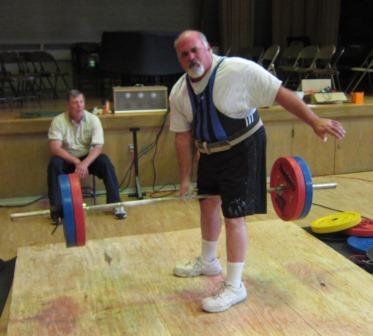
Frank Ciavattone performing one of his signature lifts, the One Arm Ciavattone Grip Deadlift, for a IAWA World Record.
The Dino Gym was well represented with myself, my father LaVerne, Chad Ullom, and Dean Ross being there to support the event. LaVerne lifted exceptionally – with his One Arm Fulton Bar Deadlift impressing me the most. I say that because he did 80 Kilograms and broke THE RECORD held by me!!! Chad did two big type lifts for his GC lifts – the clean and jerk and the front squat. Chad’s front squat of 211 kilograms broke the record held by current OVERALL WORLD CHAMP Mark Haydock. I kidded Chad by saying he was showing Mark NO RESPECT. I might add that Chad did this wearing NO knee wraps Mark…….
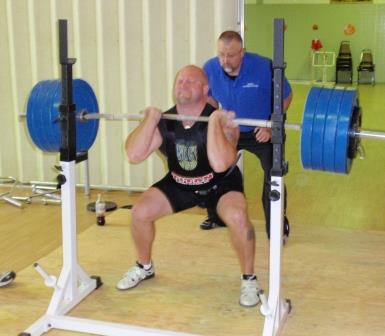
Chad Ullom performed the last lift of the 2013 IAWA Gold Cup with this IAWA World Record Front Squat.
Barry Bryan did a couple of World Records in the bench press. He made them looked very easy. I was head judge on his lifts, and after I gave him a press command, he waited another second or two to press the bar. I haven’t seen that happen very often before. Now who have I forgotten?? ART!!! Art always “steals the show” when he attends a meet. Art, at age 86, continues to make it to all of the big IAWA meets and lift. He performed a couple of Fulton Bar lifts and made them look ridiculously easy. He’s an inspiration to everyone.
Afterwards, Denny and Judy planned a nice banquet meal at a local restaurant named Risser’s Family Restaurant (it was located in Myerstown!!). It was a home-style feast that left everyone with a full belly. Most of us then retired to Denny’s place for some post-meet celebration (actually just there to drink his beer haha). Lots of good stories were told, parlor tricks were done by Steve and Chad, unbelievable tales were told by Al and Graham, and Denny made all of our eyes water (mostly with his jokes….).
